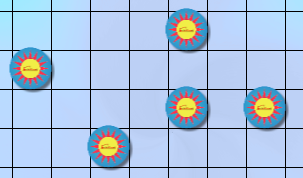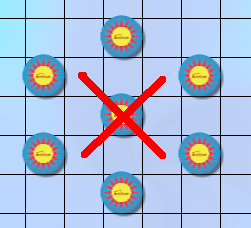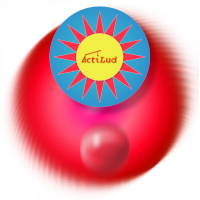Flip-flop pinball, a hybrid of pinball and billiards, is a code-breaking game in which players model the path of the ball and can test their hypotheses.
Game rules
The game board is a 9×9 grid. A number of bumpers are placed in the squares, subject to a few proximity rules. They are hidden by a plate. The player’s objective is to find their position, by shooting a ball from the edges. The ball’s path is invisible, as it travels under the plate, which is thick enough to soundproof the bumpers. The ball may come out at one edge, or it may remain under the plate, producing a tilt after a few bounces. In this case, the ball re-enters the game through the service tube.
Knowing the entry and exit squares, or the absence of an exit, the player must guess where the bumpers are located. To do this, he has two pinball machines at his disposal: pinball machine A, covered by a plate, for testing purposes, and pinball machine B, uncovered, on which he can place bumpers and test their operation at his leisure.
When the player considers that he has successfully reproduced the entire operation of pinball A with his pinball B, he stops the search and proposes his solution.
Bouncing
The ball bounces when it hits a bumper head-on:
The ball is deflected at a right angle when it brushes against a bumper:
A combination of bounces and deflections can produce a tilt:
Bumper placement
The number of bumpers is decided by the player. There is always 1 empty square between two bumpers, whether in a row, column, or diagonal.

An empty square separates each bumper.
All bumpers are accessible: the ball can hit or graze all of them, as none is placed in an area completely enclosed by the others.

No bumper is out of reach.
Scoring the results
The player does not need to note the results of each of his shots; he can use the “notepad” tool  in the toolbar, which indicates the results as they occur.
in the toolbar, which indicates the results as they occur.
The game
During the game, the player alternates between pinball machine A to discover a result, and pinball machine B on which he tries to reproduce the same behavior. When he’s finished, he clicks on the “Done” button in the Advisor window.
The score
The score calculation has been particularly carefully thought out, and numerous bonuses can be accumulated. The score depends on the number of bumpers present, the number of times that pressing Finish results in an error or not, the number of helpers received, the number of tilts discovered, the number of circuits discovered. A special bonus is added if the number of bumpers is random.
Educational interest
The Flip-flop pinball game helps students learn to model a path. Initially, students can use their B pinball machine to test their hypotheses. If, after a while, they arrive at an accurate result by simply placing the bumpers on the board, without carrying out too many checks, they’ve won! He can now imagine the path of the ball by observing the position of the bumpers, without resorting to simulation.

 Start the activity.
Start the activity.